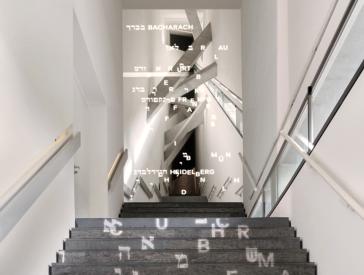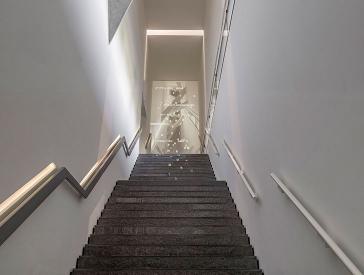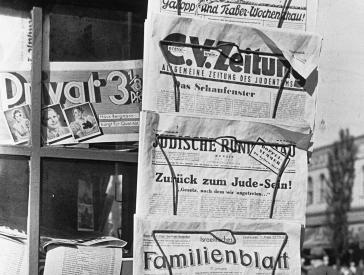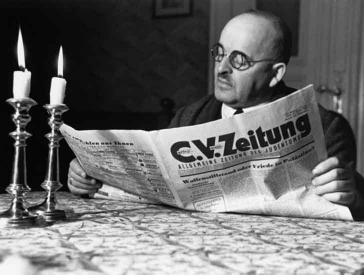"Berlin Transit. Jewish Migrants from Eastern Europe in the 1920s"
Press Invitation to the Press Conference and the Exhibition Opening
Press Release, Fri 2 Mar 2012
After the First World War, Berlin was a place of refuge and a way station for tens of thousands of Jews from Eastern Europe, most of them refugees from the former Russian Empire and Habsburg Monarchy escaping war, pogroms, or revolution. The city remained a center of Jewish migration in Europe for more than a decade. Jewish culture in Berlin blossomed with the community of Eastern European migrants, at home in many languages and with diverse networks. The exhibition "Berlin Transit" (23 March to 15 July 2012), conceived in cooperation with the research project "Charlottengrad and Scheunenviertel" at the Free University Berlin, paints a clear picture of Jewish life in the Scheunenviertel and bourgeois Charlottenburg that became known as "Charlottengrad" due to the high Russian proportion of the population there.
We cordially invite you to attend the exhibition press conference on Wednesday 21 March 2012 and to the opening on the evening of Thursday 22 March 2012.
- Kontakt
-
Press office
T +49 (0)30 259 93 419
presse@jmberlin.de
- Address
Jewish Museum Berlin Foundation
Lindenstraße 9–14
10969 Berlin
Press Conference
| Press Conference | Wednesday 21 March 2012, 11 am |
|---|---|
| Exhibition preview | from 10 am |
| Where | Old Building, first level, Education Room |
| Attended by | Cilly Kugelmann, program director, Jewish Museum Berlin Professor Gertrud Pickhan, Institute for East European Studies at the Free University Berlin Leonore Maier, exhibition project manager and co-curator, Jewish Museum Berlin Zeev Lewin, lender and former inhabitant of the Scheunenviertel |
Evening Opening Program
- Words of Welcome
- Charlottengrad and Scheunenviertel
- The Exhibition
- My Childhood in the Scheunenviertel
Cilly Kugelmann, program director, Jewish Museum Berlin
Professor Gertrud Pickhan, Institute for East European Studies at the Free University Berlin
Leonore Maier, exhibition project manager and co-curator, Jewish Museum Berlin
Zeev Lewin, lender and former inhabitant of the Scheunenviertel
To conclude, Daniel Kahn will sing Yiddish songs.
| Exhibition Opening | Thursday 22 March 2012, 7 pm |
|---|---|
| Where | Glass Courtyard, ground level |
| Admission | free |
The Exhibition "Berlin Transit. Jewish Migrants from Eastern Europe in the 1920s"
"I don’t know why all these people live in Berlin! [...] Certainly they don’t seem to be happy in Berlin and never let an opportunity pass to moan about it. Especially the Russians." What Ilja Ehrenburg said at the Romanisches Café at the beginning of the 1920s was true of a lot of Jewish migrants from Eastern Europe – Berlin was not where they had chosen to be, but was rather a place of refuge and a way station between East and West. Many of them left the city for the USA or Palestine in the 1920s.
With a wealth of previously unknown material, the exhibition follows the footsteps of Eastern European Jews through Berlin of the Weimar Republic, provides insights into why they fled and the extent of the anti-Jewish pogroms during the Russian Civil War. Pogrom drawings by Issachar Ber Ryback and historical film footage of pogroms in 1919 are striking evidence of these violent experiences.
Designed by the Berlin scenography office "chezweitz & partner," the exhibition is not set up chronologically but thematically.
„Charlottengrad and Scheunenviertel“
One exhibition room is devoted to each of the centers of Jewish life – the Scheunenviertel and bourgeois Charlottenburg. Historical photographs give an impression of the area between Grenadier-, Linien- and Mulackstrasse that was then known to many Berliners as the "misery district" and today evokes nostalgia. The genre pictures of renowned photographers such as Frederick Seidenstücker and Abraham Pisarek shape our vision of an "Eastern European Jewish shtetl" in the midst of the city. In the exhibition, these images are analyzed critically and reinterpreted in comparison with police and private recordings.
The immigrants who settled in west Charlottenburg remained far less visible. The exhibition tells the story of the family Kahan – exemplary for Russian-Jewish bourgeois Berlin – which amassed a fortune with an international oil company in the Russian Empire. Exotic studio photographs and objects of applied art from the Bezalel workshops in Jerusalem allow insight into the cultural and social life of the family.
An audio room reflects both how the migrants saw themselves and their linguistic diversity. In cooperation with Rbb Kulturradio, literary and autobiographical texts by Ilja Ehrenburg, Simon Dubnow and lesser-known immigrants were recorded especially for the exhibition in their original languages of Russian, Yiddish, Hebrew, and German.
"Golden Age": Migrant Publishers and Visual Arts
The exhibition room "Babylon" illustrates the golden age of migrant publishers through the medium of the book. Due to favorable economic conditions, a number of Russian, Yiddish, and Hebrew publishing houses existed in Berlin in the early 1920s where Jewish immigrants were involved as writers, translators, and illustrators. A cube display shows a selection of these publications including some with illustrations by El Lissitzky.
Berlin was a favorite haunt for visual artists who had fled the state regulations of the art business in Russia. The last exhibition chapter sets the impressionistic portraits of Leonid Pasternak, the constructivist sculptures by Naum Gabo, and the avant-garde paintings by Issachar Ber Ryback in an expressive dialog.
Epilog: Traces in Berlin
The exhibition epilog and the website show the way through the city of today and send visitors in search of traces to the largely forgotten places of East European Jewish migration.
The relevance to the present is continued in the exhibition "Russians Jews Germans. Photographs by Michael Kerstgens since 1992," (from 20 April to 15 July 2012). The black and white photographs document the immigration process of Russian Jews from the former Soviet Union to Germany in the last 20 years. Michael Kerstgens’ pictures show the social and religious challenges of Jewish immigrants as well as the situation of the long-time residents.
An exhibition by the Jewish Museum Berlin Foundation in cooperation with the research project "Charlottengrad and Scheunenviertel: Jewish Immigrants from Eastern Europe in Berlin in the 1920s and 1930s" at the Eastern Europe Institute of the Free University Berlin.
A lavishly illustrated exhibition catalog supplemented by 10 essays by renowned academics will be available: "Berlin Transit. Jüdische Migranten aus Osteuropa in den 1920er Jahren" (Berlin Transit. Jewish Migrants from Eastern Europe in the 1920s), edited by the Jewish Museum Berlin in cooperation with the research project "Charlottengrad and Scheunenviertel" at the Free University Berlin. 160 pages, approx. 150 color illustrations, 24.90 €. Wallstein Publishers, Göttingen. ISBN: 978-3-8353-1087-2.
For press copies, please contact: Monika Meffert, press representative at Wallstein Publishers, tel. +49 551 54898-11, presse@wallstein-verlag.de
Symposium Commencing the "Berlin Transit" Exhibition
Museum – Science – Family Memory
Perspectives of an Unknown History of Migration
The symposium will explore selected themes from the exhibition and the interaction between museum work, academic research, and family memories. The symposium will conclude with works by Russian-Jewish composers performed by the soprano Tehila Nini Goldstein and the pianist Jascha Nemtsov.
| Symposium | Saturday 24 March from 9 am to 5.30 pm |
|---|---|
| Concert "A Capella Musicians" by Jascha Nemtsov and Tehila Nini Goldstein | Saturday 24 March from 9 am to 7.30 pm |




